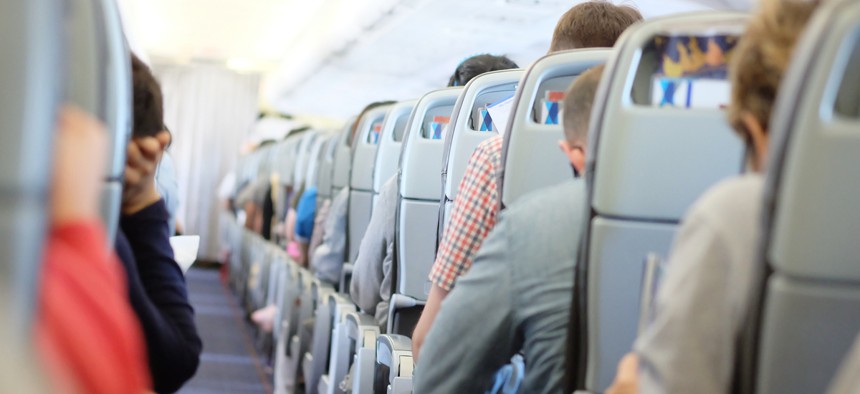What Would Flying From New York to Shanghai in 39 Minutes Feel Like?

Awasada Kalayanamit/Shutterstock.com
Elon Musk’s proposed Earth transport system better stock barf bags.
It’s just after sunrise in New York City. The sky is bathed in pinks and orange as people walk along a long dock toward a white ship. They board the vessel and it sails out to a launchpad further out in the water, where a spaceship strapped to a giant rocket awaits. After they pile in, the rocket blasts off into the atmosphere. About 39 minutes later, they land halfway around the world, in Shanghai.
This is the scenario imagined by SpaceX founder Elon Musk, who discussed the futurist transport system in a speech in Australia last week about the company’s long-term ambitions. The not-yet-built system—which Musk nicknamed BFR, for “big fucking rocket”—would, someday, ferry passengers from one major city to another. Long-distance trips from Bangkok to Dubai, or from Honolulu to Tokyo, for example, would take about 30 minutes and cost about as much as an economy airline ticket.
(The BFR would also subsume the duties of SpaceX’s current fleet of rockets and spacecraft, like the Falcon 9 and Dragon capsule, by launching satellites into orbit, transporting astronauts and cargo to the International Space Station, and even bringing humans to the moon and Mars.)
The news of the Earth transport system was thrilling for Musk’s fans, for whom a speech from the entrepreneur about space exploration is akin to an Apple launch event. The future is really here, or at least quickly approaching! Imagine setting your smartphone to rocket mode instead of airplane mode. Rocket travel, an animated video of this future seemed to suggest, would be a breeze.
Well, not necessarily. To make a half-hour trip, the BFR would have to travel thousands of miles per hour, with a maximum speed of about 16,700 miles per hour, according to SpaceX. The flight would expose passengers to sensations they don’t usually encounter while traveling, like intense gravitational forces and weightlessness. The spaceship would definitely need to stock barf bags.
Musk explained in a tweet that travelers would experience g-forces between 2 and 3, which means twice or three times their body weight. “Will feel like a mild to moderate amusement park ride on ascent and then smooth, peaceful, and silent in zero gravity for most of the trip until landing,” he said.
“That may not be a very comfortable way to travel,” said Ge-Cheng Zha, a mechanical and aerospace professor at the University of Miami who studies supersonic flight.“Not everyone can take it.”
The ride will be most intense during landing and takeoff. The rapid acceleration and deceleration could lead to motion sickness. So could a quick peek out the window during a particularly twisty maneuver. “There’s a disconnect between the g-force and what the person sees, which can lead to severe motion sickness,” said Andy Feinberg, a geneticist at Johns Hopkins University in Maryland who studies astronaut health (and applied to be an astronaut himself in 1979).
Feinberg has flown aboard NASA’s now-retired zero-gravity plane, which simulates weightlessness by taking a series of dives. The speed of the aircraft matches the speed of the passengers as they fall, which creates the experience of free-falling. Feinberg remembers not everyone on board could handle the shifts.“The NASA people, the astronauts, and I were having the time of our lives,” he said. Everyone else around them was throwing up.
Aside from the flight experience and the discomfort it may bring, there’s a host of other factors Musk and his engineers will need to consider before the BFR becomes reality. While the actual trip may indeed take about a half-hour, preparing and unloading the passengers could take hours. The nature of the travel could increase the time required for security checks, luggage checks, and whatever new safety procedures flight attendants may have to present. (At least some flight attendants, for what it’s worth, seem game for the BFR. While it’s too soon to give a “definitive opinion” on rocket travel, Sara Nelson, the president of the Association of Flight Attendants-CWA International, said flight attendants have the “flexibility to adapt to new conditions.”)
There’s also the question of fuel. Launching the BFR, which will stand 106 meters tall, nearly double the height of the Falcon 9, will require tremendous energy, Zha said. A rocket is much harder to get off the ground than, say, a supersonic plane, he said. The Concorde, a now-retired commercial supersonic airliner that carried passengers from New York to London in under three hours, among other destinations, used about three times as much fuel as a Boeing 747. “The reason we use rockets for space delivery is because there’s no other options,” Zha said. “On Earth, airplanes are way more efficient.”
The transport system will also face questions from the U.S. government and other nations in the BFR’s flight path about the rocket’s safety risks and environmental impact. The rocket’s introduction would require the regulation of an entirely new commercial industry.
Still, many won’t be deterred. The BFR doesn’t exist yet, so the coolness factor outweighs all others. Asked whether he would hitch a ride on the BFR, Feinberg said, “in a second.”






